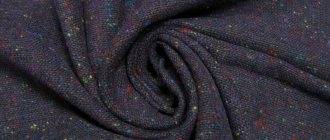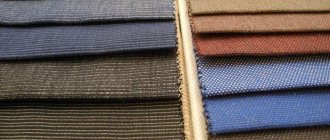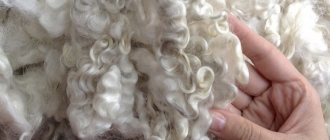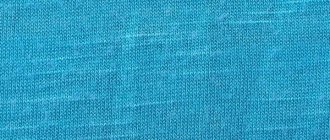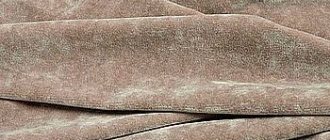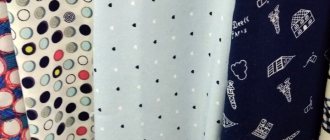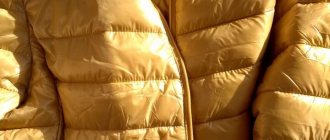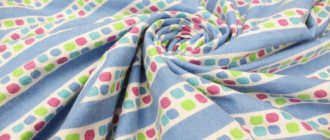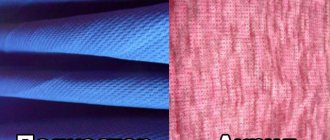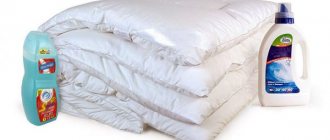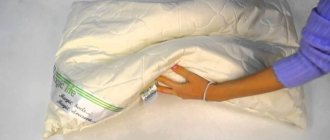History of fabric
Acrylic is a young fashionable fabric. The technology for producing artificial matter from gas was invented in America in the mid-20th century. In the laboratories of the large chemical company DuPont, for a long time, new types of fibers were developed, close in structure and properties to natural threads.
The predecessor of acrylic was the soft fluffy fabric orlon, reminiscent of wool. The only downside was its uneven coloring. In the process of improving the material, scientists invented a method of coloring the material in the melt. The resulting fibers acquired the name acrylic. The international name for acrylic fabric is PAN.
How it is produced
Acrylic is produced by spinning a continuous filament from natural gas. The creation process is a sequence of complex chemical reactions.
Hydrocyanic acid and acetylene are separated from the gas. The elements polymerize and turn into fiber. Acrylic is painted in a liquid state. The threads are dyed from the inside. Because of this, the color of acrylic is durable and the coloring is uniform. The fabric pattern is clearly visible on the smooth surface.
Photo source: Depositphotos.com
To create a canvas from acrylic fibers, a variety of weaving techniques are used: knitted weaving, jacquard weaving, matting, plain weaving. Fabrics have different textures and differ in appearance.
Application
- Warm clothes for children and adults are made from acrylic material : jumpers, sweaters, sweaters, jackets, light coats.
- Blended acrylic is suitable for sewing linen and casual wear : trousers, skirts, dresses, blouses.
- Acrylic is suitable for sewing sports suits and swimsuits .
- The material is used to create accessories : hats, mittens, gloves, scarves, children's shirtfronts.
- Acrylic is suitable for sewing home textiles : bedspreads, rugs.
- Curtain acrylic is used to create curtains , does not fade under the bright rays of the sun, drapes beautifully, and allows you to create fixed folds.
- Acrylic fabrics are used to create awnings, transport covers, and awnings .
- In the advertising industry, acrylic canvas is used in the production of banners and streamers.
- The inclusion of reinforcing threads in the material allows the use of acrylic as furniture upholstery .
- Acrylic fibers are used to produce knitting yarn . It is used in hand and machine knitting, fits well into the fabric and does not delaminate. Suitable for knitting clothes and toys.
Acrylic fibers undergo strict sanitary and hygienic control; they are safe and harmless to health, suitable for making clothes even for small children.
Wool with acrylic added - what is it like?
Wool is often mixed with acrylic.
So, for children's yarn, these threads are mixed in a ratio of 50% to 50%. You can also find completely different combinations of acrylic and wool; accordingly, certain characteristics are achieved in the yarn or fabric.
Thanks to wool in the blended fiber, the following characteristics can be improved:
- creating warmer yarns;
- improved breathability;
- the material becomes more susceptible to absorbing excess moisture.
By adding acrylic to the thread, you can improve:
- elimination of severe shrinkage;
- reduction in the formation of coughs and abrasions;
- reducing the allergenicity of the material.
Most often, mixed fiber is preferred in children's products, due to the fact that this combination makes it softer and more delicate when in contact with the skin. Also, people who have an allergic reaction to contact with pure wool often prefer a mixture of acrylic and wool.
Description of the fabric: properties and composition
Acrylic is called artificial wool; according to its characteristics, it can replace and sometimes surpass natural wool.
Acrylic fibers are highly durable and can withstand exposure to chemicals, acids and solvents.
Acrylic fabric can be painted in any tone, from bright to soft pastel. The colors always turn out rich and rich.
According to color options, acrylic is divided into:
- plain;
- printed - a pattern is applied to the surface; it can be a wide or narrow strip, a floral print, or a geometric pattern.
Photo source: Depositphotos.com
The percentage of acrylic fibers in the fabric ranges from 5% to 100%. Pure acrylic without additives is rare. To improve performance characteristics, it is combined in different proportions with natural fibers: wool, mohair and cotton. It is possible to combine acrylic with viscose or synthetics.
The most popular combination is acrylic and wool. Things turn out warm, soft, not itchy, and keep their shape well. The ideal ratio is 30% acrylic and 70% wool.
What is Acrylic wool
Acrylic (or as it is also called acrylic fiber, acrylic wool) is the result of the work of the DuPont company (USA). For more than 10 years, the company has been working to improve synthetic material such as nylon. The result was the emergence of acrylic fiber.
The raw materials for the production of thread are products of oil, coal, and natural gas. The chemical formula of acrylic is quite complex. May fluctuate. But in principle, acrylic fibers include all those that contain at least 85% acrylonitrile. In addition, the composition must contain a comonomer. The latter serves to make the fiber more susceptible to dyeing. It does not fade, that is, it is resistant to ultraviolet radiation. This determines the variety of colors that are presented on the shelves of stores selling acrylic fabrics and threads.
Technologically, acrylic thread can be obtained in two main ways:
- dry felting;
- wet felting.
Are acrylic and wool the same thing?
Acrylic is a fiber obtained artificially from chemical components. And despite the fact that it imitates natural wool as much as possible in its appearance, it is still unnatural.
In the case of natural sheep or camel wool, everything is completely different. Natural wool is a keratin fiber. It is obtained by cutting the hair of sheep (possibly other animals, such as camel, goat, yak, rabbit, dog, etc.) and further processing and spinning it.
Speaking about comparing the two types of fiber, it is worth noting that, perhaps, although they sometimes look similar, there are still many differences between them, in such properties as:
- tactile;
- allergenic;
- hygroscopic;
- heat retaining;
- breathable;
- ability to scrape;
- shrinkage during washing;
- wear resistance;
- duration of operation.
It is impossible to say which is better - wool or acrylic . Everything here is very individual - who prefers what. Then it is very important what product is planned to be created from this or that fiber.
Since acrylic and wool have strengths and weaknesses, in order to create the highest quality thread, wool and acrylic are often mixed in one thread.
Advantages and disadvantages
Acrylic has many positive properties :
- softness, pleasant to the touch;
- ability to retain heat well;
- quick drying;
- UV resistance, bright, even color does not fade in the sun;
- elasticity;
- hygiene, the ability to resist the growth of mold, bacteria, parasitic insects;
- stability of shape and color, products wrinkle little, do not shrink, and do not fade with repeated washing;
- hypoallergenic.
Care instructions
- Acrylic products that are constantly worn require frequent washing. It is recommended to wash them 1-2 times a week to avoid heavy soiling.
- It is better to wash by hand in water at room temperature. Machine washable in a delicate cycle using a mild conditioner, water temperature should not exceed 30 degrees.
- When spinning the product, do not twist it.
- Dry in a horizontal position, laid out on a flat surface away from radiators and heaters.
- Things should not be over-dried.
- It is not necessary to iron the products; they wrinkle a little and restore their shape on their own. If necessary, iron using a warm iron through a protective cloth.
What is warmer in winter: wool or acrylic?
Despite the fact that acrylic is a significant competitor to wool, it is less hygienic and wicks away sweat worse, without absorbing excess moisture from the skin. By preventing heat from escaping, it, unlike wool fibers, deprives a person of the air gap between the body and clothing. Such fabrics do not adapt to changes in the environment: in hot weather, wearing such clothes is stuffy and hot, in extreme cold there is a risk of freezing.
It is strictly not recommended for people with excessive sweating to wear acrylic products!
The natural uniqueness of wool products, which consists in a structure that retains heat in various weather conditions, allows you to immediately appreciate their superiority. They will protect the owner from getting wet both outside and under clothes, will keep you warm when the temperature outside is very low and will allow the body to breathe in a hot room.
In a dry room with a comfortable temperature, acrylic products give a feeling of comfort and warmth, but in conditions of winter weather changes it is better to give preference to natural woolen or mixed fabrics with a low acrylic content.
Recommendations for use
- A simple way to distinguish acrylic is to perform a burn test. When exposed to fire, acrylic material begins to melt, spreading a sour chemical smell and black smoke around it. When it cools, a solid mass forms that cannot be rubbed between your fingers.
- If an acrylic product shrinks during washing, you can try to return it to its original shape. You should soak the item in warm water with added conditioner for 15 minutes, then wring it out with a towel, carefully spread it on a horizontal surface and carefully stretch it in different directions.
- You can try to revive a shrunken item by putting it on yourself while wet.
- If the product is stretched, it must be washed and rinsed, following the care instructions. Often these simple steps help correct the situation.
Is it better to choose wool or acrylic?
It is impossible for a traditional person to choose wool or acrylic without knowing the properties and without considering the negative and positive aspects of these fabrics.
First of all, it is necessary to clearly express which fibers are generally considered acrylic and which are wool.
Wool is a warm, real yarn that is obtained after combing or hair-dressing animals.
Acrylic is a chemically produced yarn, similar in appearance to wool, but with its own qualities.
Characteristics and characteristics of wool
There are a large number of varieties of wool, depending on the animals from which it is obtained. There are 4 types of sheep alone, which differ not only in appearance, but also in qualitative properties:
- thin - downy, strong and elastic;
The finest quality fine wool is called merino.
- semi-fine - consists of fluff of poorer quality or fine hair, no impurities, long with a strong shine;
- semi-coarse - a mixture of fluff and fine hair;
- coarse - a mixture of fibers of various types, and in terms of its own properties it is in last place.
More than 95% of all wool production comes from sheep.
In addition to sheep, the wool of other animals is used, named after their type:
- Angora hare (angora) - soft, tender and fluffy, unfortunately, wears out very quickly;
- Angora goats (mohair) - warm, does not pill, has good moisture-wicking properties, but is rough to the touch;
- cashmere goats (cashmere) - soft, but not warm;
- camel - warm, but rough to the touch;
- alpaca - similar in appearance to cashmere, but warmer, lightweight and almost resistant to deformation.
The alpaca llama belongs to the camel family. Its wool is one of the most valuable and is rarely used in its pure form.
Good side
Real wool has a number of undeniable positive qualities.
Items made from wool fibers create a comfortable warm feeling, softness and coziness. The elasticity and plasticity of wool fibers give products stability and endow them with wear-resistant qualities. Thanks to the fleecy nature of wool fibers, they retain pleasant air perfectly. Therefore, wool products have high heat protection properties, and wool itself is recognized as one of the excellent natural insulation materials.
How to stretch an elastic band on panties How to stretch panties that have shrunk after washing
Wool material allows the skin to breathe and has high moisture-absorbing qualities. These qualities help it remain dry and warm even under intense exercise, which provokes profuse sweating in a person.
Because there is no sauna effect in wool products, the proliferation of bacteria that causes the aroma of sweat in such clothes is virtually zero.
The therapeutic properties of wool have become very popular. Its “dry heat” is recommended for colds, diseases of the musculoskeletal system, circulatory disorders and other pathological conditions.
There is an opinion that the beneficial negative charges of wool fibers can remove harmful positive ones from a person.
Bad side
Despite a variety of important advantages, wool also has bad characteristics.
She is capricious in her work and is not suitable for everyone:
- if there are coarse and hard threads, it can cause irritation;
- can provoke allergies;
- if stored improperly, it risks becoming a breeding ground for moths;
- washing can be the culprit of shrinkage;
- deformation is possible during drying;
- Long-term wearing turns out to be the basis for the occurrence of pellets.
When very wet, wool items become heavy and take a very long time to dry, so if exposed to conditions of very high humidity, they may not live up to the expectations placed on them.
What is acrylic, description of the material
Acrylic fibers are not so diverse in their own properties.
Over their slightly more than seventy-year presence on the market, they have undergone small improvements, but in general, from the very beginning of their existence they acquired the status of particularly high-quality synthetics.
Network gas is considered the basis for the production of acrylic fibers.
Fibers are divided into:
- acrylic, containing more than 85 acrylonitrile and used for the manufacture of fabrics for clothing, home textiles for children's products, and also soft toys;
- modacrylic, in which from 35 to 85% acrylonitrile, they are used to create fake fur, wigs, pile fabrics, fabrics for furniture, carpets, toys and clothing for children.
Price differences between acrylic-based materials directly affect the quality and appearance of the products. Cheap ones will be rough, stuffy and creaky with obvious artificial signs. Things of good quality and, therefore, much more expensive, are externally distinguishable from natural ones with great difficulty, but are soft and airy to the touch.
The specificity of acrylic, as an artificial fiber, is considered to be a permanent thread, which allows you to make a smooth and even fabric, and also obtain a clearly defined pattern of weaving threads.
For special processing of the material, permanent acrylic fiber is cut into pieces of equal length - staples. Products made from staple yarn resemble wool. Therefore, the name “artificial wool” was assigned to acrylic.
The demand for acrylic fabrics can be explained by the fact that their good positive characteristics can compete not only with artificial, but also with natural materials.
The main positive quality of acrylic is its hypoallergenicity; it is excellent for people with very high sensitivity. In addition to this, the advantages of acrylic fibers include the following characteristics:
Curtains and cornice
- the ability to maintain a delightful appearance and not be subject to deformation or shrinkage;
- stability, ability to withstand active physical and chemical influences, resistance to wear;
- low hygroscopicity and quick drying;
- not affected by moths and dust mites;
- the ability to store color for a very long time;
- low thermal conductivity;
- softness and similarity to products made from real wool;
- small price.
Despite the fact that the list of important advantages of acrylic-based materials is very large, they have a number of serious disadvantages that are reflected in consumer demand.
Among the disadvantages, first of all, I would like to emphasize the low air exchange criteria of acrylic. The body does not breathe in it, and ultimately sweating increases. Despite this, acrylic fabrics retain heat less well.
To these disadvantages we must add the following:
- acrylic is highly electrified;
- it should not be overdried or exposed to high temperatures when washing - this causes the fibers to become stiff and lose their plasticity;
- cheap products quickly lose their appearance, roll up, and can stretch;
- It perfectly absorbs fats, so such stains are removed with great difficulty.
